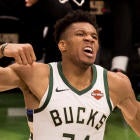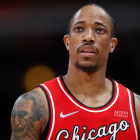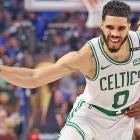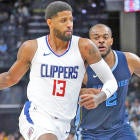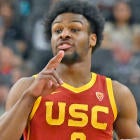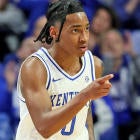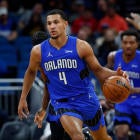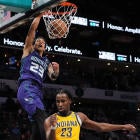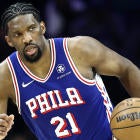These tiers assume eight category settings. Within each tier, players are listed in recommended draft order:
Tier 1: Potential first overall picks
Giannis Antetokounmpo, Bucks
Anthony Davis, Lakers
Antetokounmpo is my first overall pick this season, and that's only because I'm a little afraid of the injury risk that comes with Davis. If you ignore games played and focus only on per-game production, I expect Davis to finish No. 1 overall this season. Both of these players offer a ton of versatility, which is good, because there's a long gap between the first pick and your second and third selections. Both players are perennial fixtures in the "stocks" (steals plus blocks) leaderboard. They score in bunches, are top-10 rebounders, and rank near the top of the league in field goal impact.
Tier 2: The universal sixth pick
The Fantasy landscape has pretty much come to a consensus that Antetokounmpo, Davis, Karl-Anthony Towns, James Harden and Steph Curry should be the top five picks, and that any order within the five is reasonable. There is also a consensus that while Jokic isn't quite inside that top tier -- he stands alone on the next level. His ability to rank among the league leaders in assists from the power forward or center spot is a unique skill, and arguably one of the biggest competitive advantages in all of fantasy. He helps in every category, and he should be a top-three pick in leagues that reward triple-doubles. He has no injury history to speak of, and he has improved every season.
Tier 3: Solid second-round targets
LeBron James, Lakers
Deandre Ayton, Suns
The picks between seven and roughly 30 are a minefield this season. It feels like every player is either an injury risk, in a potentially worse new situation, or at risk of load management. Many players meet two or three of those descriptors. James, now the active leader in total minutes played, has to be considered a missed games risk. Furthermore, when active, his fantasy value has fallen in recent years. After a decade of top-three finishes, he finished between five and nine four seasons in a row, and last year fell outside the top-15. He's still a fantastic player, but he's not the first-round lock he once was. Ayton's situation has barely changed, and I'd argue it has improved. The addition of Ricky Rubio helps everyone in the Suns offense, as he is a massive upgrade at point guard. The Suns are a lot better this year, at least on paper, but they remain one of the worst teams in the West, and they have tended to rest players once they get eliminated from playoff contention.
Tier 4: Risky second or third picks
Pascal Siakam, Raptors
Kristaps Porzingis, Mavericks
Siakam's meteoric Fantasy rise has resembled a player he's often compared to: Draymond Green. But can Siakam's career arc continue its rise now that he's already inside the top 50? Siakam should see a lot more offensive responsibility this season, but he'll also see a lot more defensive attention. The same can be said of Porzingis, though for him the risk is more health-related. He's already shown that he can be a top-25 player, but his last NBA game was 20 months before opening night.
Tier 5: High-level building blocks
Zion Williamson, Pelicans
Draymond Green, Warriors
Al Horford, 76ers
LaMarcus Aldridge, Spurs
Blake Griffin, Pistons
John Collins, Hawks
The first rookies drafted in Fantasy almost always go too early. But Williamson really does look one of a kind. In addition to the risks inherent with all rookies, the Pelicans have enough depth that they can limit his minutes. But he just looks like a monster. College stats do not directly translate to the NBA, but 23 points (68.0 FG%), nine rebounds, two assists, two steals and two blocks per game as a freshman at Duke is mind-blowing.
Green, Horford, Aldridge and Griffin are all excellent, aging, and provide above-average assists for a power forward. But all come with important questions. Will Green's value rise now that the Warriors are down two stars, or will it fall now that he has secured his massive contract extension? How much will Horford's stats suffer as he transitions from a primary option for the Celtics to a secondary weapon sharing the frontcourt with Joel Embiid? Can Aldridge, the oldest of the four, stave off decline for another year? Finally, can Griffin stay healthy, and can he repeat what might have been the best season of his career?
There's a lot of excitement for Collins, and I wouldn't be surprised to see his ADP rise above Williamson. He averaged just shy of 20 points and 10 rebounds in his sophomore campaign, and he's good enough from the free-throw line to do no meaningful harm there. His lack of defensive production, however, kept him outside of the top-50 last season. His defense improved as the season wore on, but he'll need to maintain that improvement in order to justify some people's lofty expectations for him.
Tier 6: Top-40 potential
Tobias Harris, 76ers
Lauri Markkanen, Bulls
Jaren Jackson Jr, Grizzlies
Robert Covington, Timberwolves
Danilo Gallinari, Thunder
Kevin Love, Cavaliers
I should start by pointing out the comparative strength of the power forward position. The power forwards with SF eligibility in this tier were a part of Tier 3 in the small forward tiers article. I see significant gaps between each of the tiers listed above, but a Tier 6 power forward is legions better than a Tier 6 shooting guard.
Harris is an excellent well-rounded producer, but the strength of the 76ers' starting lineup should cause some concern. His usage rate fell significantly when he was traded from the Clippers to the 76ers, and the addition of Al Horford could cut into Harris' workload. Harris was 14th in minutes per game last season.
Markkanen and Jackson have massive upside, though both only played 58 games last season. Markkanen is arguably the best 3-point shooter among all power forwards and centers now that Dirk Nowitzki retired (unless that title still belongs to Kevin Love). Jackson, on the other hand, is a near-lock to provide "1-1-1" value (one 3, one steal and one block per game). Jackson finished inside the top-90 last season, despite averaging only 26.1 minutes per game.
Covington, Gallinari, and Love have demonstrated top-40 – and, for limited windows, top-30 – value. But they also have some troubling injury histories. Covington has played more than 70 games just once, and he missed the majority of last season with a knee injury. Love was a top-10 producer back in his Timberwolves days, and he finished between 30th and 50th when playing alongside LeBron James. But we haven't really seen what post-LeBron Love can do. Injuries limited him to 22 games last season, and just 27.2 minutes per game when he did play. He also missed at least 20 games in the two previous seasons, as well as in half of his seasons with the Timberwolves. Gallinari hasn't played more than 71 games this decade, and he's played 62 games or fewer in seven of his 10 seasons. As if to underscore his wrought medical history, he's currently recovering from an emergency appendectomy, though that is unlikely to impact his NBA season.
Tier 7: Semi-reliable contributors
Derrick Favors, Pelicans
Larry Nance, Cavaliers
Julius Randle, Knicks
Serge Ibaka, Raptors
Marvin Bagley, Kings
Aaron Gordon, Magic
This tier has all sorts of players, with a wide range of risk profiles. Favors and Randle have both flashed as Fantasy studs. Favors finished inside the top 60 for three seasons from 2013-16, while Randle was a top-50 player after entering the starting lineup in December, and he had a two-month stretch inside the top-40. Favors' situation seems improved, but it is impossible to figure out how the Pelicans will distribute their minutes. Randle was the Knicks' headlining free agent signing, but all of their other free agents play the same position, and we don't know how much that will hurt him. They offer the highest risk/reward combo.
Nance and Ibaka are both too talented to be ranked this low, but they also play at their teams' deepest position and do not project as starters when their teams are fully healthy. Even off the bench, they are likely to see quality minutes and remain inside the top-90, but they both probably need either an injury above them or a trade to get back inside the top-60.
The Kings want Bagley to be a cornerstone of their future, but we must remain careful when it comes to projecting how much a player will improve. I have him as a top-90 overall Fantasy pick, but he barely made it inside the top 120 last season. Gordon is only 24 years old, though the Magic continue to add big men every offseason.
Tier 8: Last chances
Wendell Carter, Bulls
Paul Millsap, Nuggets
Rui Hachimura, Wizards
Willie Cauley-Stein, Warriors
Dario Saric, Suns
Brandon Clarke, Grizzlies
As strong as the power forward position is, it does eventually fall off a cliff. While there will probably be more power forwards drafted in the top 100 than any other position, they might have the fewest options in the 100 to 150 range. With the exception of Carter, every one of these players could be on waivers long before Thanksgiving. That said, all of them have the upside to finish inside the top-100.
Though I'd prefer to draft them later, I'm fine with taking Carter and Hachimura at pick 90 if I didn't like what's left on the board. Carter was startable in his injury-shortened rookie season and will probably see more minutes as a sophomore. Hachimura is one of my favorite late-round fliers in standard sized leagues. Every year, at least one underhyped rookie works his way into Fantasy relevance, and Hachimura has essentially zero competition for minutes on an awful-looking Wizards squad.
Millsap has managed to stay inside the top-100 even as he's aged and his role has declined, but the acquisition of Jerami Grant poses a new threat to Millsap's minutes. If Millsap can keep his minutes above 26 per game, he'll probably be worth rostering. Any higher, and he could glimpse the top 100. Any lower, and he'll probably land on waivers.
Cauley-Stein and Saric are in similar situations. Both have tantalizing Fantasy-friendly skill-sets, but both are entering new situations and their status on their respective depth charts remains unclear. Clarke can be viewed similarly to his former Gonzaga teammate, Hachimura. If things break right for the rookie, he could be a Fantasy staple. I have Hachimura above Clarke for two reasons. First, the Wizards have no other options at power forward, while Clarke and Jaren Jackson both are best suited to power forward. Second, Hachimura's college stat profile is better for Fantasy.
Tier 9: Dart throws
Kyle Kuzma, Lakers
Thad Young, Bulls
It's the end of the draft. Maybe you're in a very deep league. Or maybe you're worried about your SF depth. Well, these players exist. They might even provide some help. But it's largely dependent on them seeing 30-plus minutes per night, and that would likely only happen due to injuries around them, which is never something to bank on in Fantasy.








